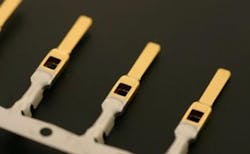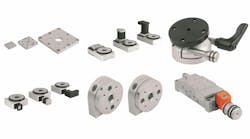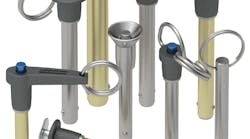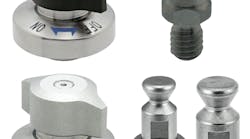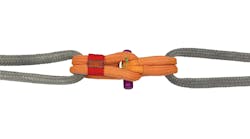Electroplating vs. Electroless Plating
In general, plating and finishing processes can be defined as any process used to protect, improve the appearance, insulate, or to increase the corrosion protection, conductivity, and/or solderability of the substrate material. These processes fall into 2 primary categories:
- Electroplating
- Electroless Plating
This Tech Bulletin provides an overview of how these processes work, discusses the differences and benefits of each one, with a focus on how each can best be used for various types of production applications.
Electroplating
Electroplating is a process by which metal ions migrate via a solution from a positive electrode (anode) to a negative one (cathode). An electrical current passing through the solution causes the workpiece at the cathode to be coated by the metal in the solution (Figure 1).
Electroplating is a cost effective method to improve the properties of the base material. Plating protects the underlying material by either of 2 mechanisms:
- Sacrificial Protection Zinc and Cadmium protect the base materials they cover by sacrificially corroding in preference to the substrate. This takes place because they are typically more reactive than the underlying substrate material.
- Mechanical Protection Copper, Nickel, Chromium, Tin, and most other metals provide mechanical protection, as long as the coating remains intact. If there are any defects in the plating layer, the substrate will corrode before the plating does.
Standard electroplating practices typically involve the following production stages seen in Figure 2.
Each of these stages are common to all types of deposition. Cleaning is vitally important; without adequate cleaning and pre-treatment of the substrate, any subsequent deposits will be doomed to fail. Undercoats and final deposits are usually specified by customers to meet the respective specifications that are necessary to provide functionality to the finished component, and is very rarely discussed with the finisher at the design stage.
Electroplating processes are compatible with a wide range of finishes, including the following precious and non-precious metals:
Precious Metals
- Gold – Hard (Cobalt and Nickel hardened)
- Gold – Soft (wire bondable)
- Pure Palladium
- Palladium (wire bondable)
- Indium
- Silver
- Silver (wire bondable)
- Silver Tin
Non-Precious Metals
- Copper
- Nickel
- RoHS compliant Tin (whisker mitigating)
- Tin (matte and bright)
- Tin Lead
- Nickel Phosphorus (wire bondable)
- Tin Silver
Electroplating processes can be implemented using a variety of methodologies, including barrel plating, rack plating and continuous reel-to-reel plating (Figure 3). For parts that have already been singulated, barrel plating is typically the most viable process, with the alternative being a timeconsuming process of rack mounting the parts to uniformly present them for plating. Rack mounting or masking each part is required in order to apply selective plating on a portion of pre-singulated loose parts.
To overcome these process limitations of singulated parts and to achieve the highest possible throughput, continuous reel-to-reel plating is the best alternative. The reel-to-reel approach, as pioneered by Interplex, uniformly presents all reeled parts to the plating process, which enables much greater precision and consistency along with very high throughput and yields. In addition, the consistent presentation of the continuously reeled parts allows for a variety of partial plating options, such as selective plating, controlled depth plating, and stripe or spot plating. After the parts are plated in a single pass and rolled up on the finished reel, they are ready for automation-friendly use in subsequent assembly processes.
Electroless Plating
Electroless plating (Figure 4), as the name implies, involves the production of coatings from solutions of metal ions without the use of an external source of electrical energy. This definition can include each of the 3 following techniques:
- Immersion Plating Immersion plating involves the deposition of a more noble metal in the electrochemical series onto the surface of a less noble metal. The best example of this is when steel (iron) is immersed in a solution of copper ions, and the copper is deposited onto the steel substrate. This technique has few applications due to the thin, nonadherent coatings that are typically produced.
- Homogenous Chemical Reduction In homogenous chemical reduction, a chemical reagent provides electrons for the reduction of metal ions for deposition onto a substrate. Thicker coatings can be deposited by this method, but adhesion issues still exist. Another disadvantage of this process is that the metal ion solution and the chemical reducer must be kept separate, otherwise they will immediately react.
- Autocatalytic Deposition Autocatalytic deposition utilizes chemical reducing agents to provide the electrons for plating, but the treatment solutions are formulated to deposit onto naturally catalytic surfaces, or ones which can be rendered catalytic. The deposit itself is catalytic, thus the reaction is selfperpetuating. As a result, the coating can be built up to a significant thickness and is highly adherent.
Differences Between Electroless and Electroplating Approaches
Both electroplating and electroless plating offer advantages for process engineers, depending on the specific requirements of the applications.
Electroplating Benefits
- Overall faster deposition
- Highest throughput (with reel-to-reel electroplating)
Electroless Plating Benefits
- Applicability for plating either metallic or non-metallic parts (e.g. ceramics)
- Ability to achieve greater uniformity
Generally, electroplating is more applicable for metallic parts that need to be produced cost effectively in very high volumes— for example, electrical interconnects, fasteners, and pins. On the other hand, electroless plating is oftentimes more suited for parts requiring a high degree of uniformity, such as medical devices, and for plating non-metallic parts, such as ceramics.
Figure 1 - Electroplating Process
Figure 2 - Electroplating Process Steps
Figure 3 - Reel-to-reel Plating Line
Figure 4 - Electroless Plating Process
